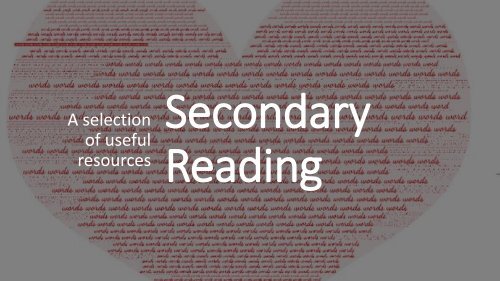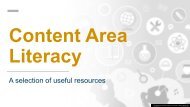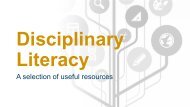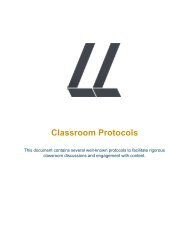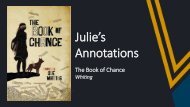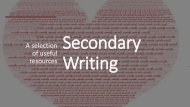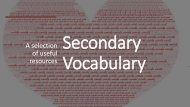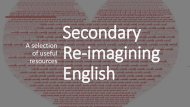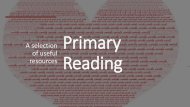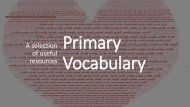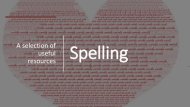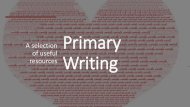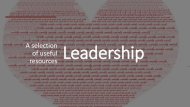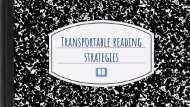Secondary - Reading Magazine 2021
You also want an ePaper? Increase the reach of your titles
YUMPU automatically turns print PDFs into web optimized ePapers that Google loves.
A selection<br />
of useful<br />
resources<br />
<strong>Secondary</strong><br />
<strong>Reading</strong>
Closing The <strong>Reading</strong> Gap<br />
Closing the <strong>Reading</strong> Gap explores the intriguing<br />
history and science of reading. Quigley explores the<br />
knowledge and skills expert reading teachers need<br />
to teach reading and to nurture pupils' desire to<br />
read.<br />
Quigley does an excellent job summarizing the<br />
science of teaching reading, explaining the “mental<br />
model” that readers construct, and offering<br />
practical strategies.<br />
Quigley (2020)
Comprehension &<br />
Collaboration:<br />
Inquiry Circles in Action<br />
Comprehension and Collaboration: Inquiry Circles in<br />
Action provides a guide for teachers who want to<br />
implement well-structured, student-led, crosscurricular<br />
projects.<br />
It lays the foundation for inquiry circles by<br />
discussing the current research and practices<br />
behind comprehension instruction and classroom<br />
collaboration.<br />
Harvey & Daniels (2004)
Disrupting Thinking:<br />
Why How We Read Matters<br />
Beers & Probst (2017)<br />
In the book, Disrupting Thinking authors Beers & Probst tackle<br />
one of teachers’ greatest challenges: student apathy. They<br />
explain that too many students remain disengaged and reluctant<br />
readers due to the misrepresentation they continue to receive<br />
regarding why we read and how we should approach the texts<br />
we read.<br />
Disrupting Thinking is an exploration of how teachers help<br />
students become critical thinkers.<br />
The book presents a vision of what reading and what education<br />
across all the grades could be. It presents new strategies and<br />
ideas that help classroom teachers create engagement and<br />
relevance; encourage responsive and responsible reading;<br />
deepen comprehension and develop lifelong reading habits.
Strategies That Work<br />
Harvey & Goudvis (2017)<br />
Harvey and Goudvis offer new perspectives on how to explicitly<br />
teach thinking strategies so that students become engaged,<br />
thoughtful and independent readers.<br />
Harvey and Goudvis tackle close reading, close listening, text<br />
complexity, and critical thinking in a new chapter on building<br />
knowledge through thinking-intensive reading and learning.<br />
Other fully revised chapters focus on digital reading, strategies<br />
for integrating comprehension and technology, and<br />
comprehension across the curriculum.<br />
Strategies That Work (3 rd edition) explains the research behind<br />
comprehension and looks at 8 strategies that should be<br />
explicitly taught to students to increase their comprehension of<br />
text. It also provides lesson ideas and student work samples.
<strong>Reading</strong> with Presence:<br />
Crafting Mindful, Evidence-Based<br />
<strong>Reading</strong> Response<br />
Marilyn Pryle offers a framework for crafting mindful,<br />
evidence-based reading responses. Pryle argues that we can<br />
help students find their voices and deeply understand texts<br />
when we invite them to write and share short reading<br />
responses. Her suggested categories for reading responses<br />
offer students plenty of choice and the writing examples she<br />
shares in her book illustrate students’ deep thinking about a<br />
rich variety of texts, in a range of genres from both wholeclass<br />
and independent reading.<br />
Marilyn Pryle (2018)
Talk About Understanding:<br />
Rethinking Classroom Talk to Enhance<br />
Comprehension<br />
Ellin Oliver Keene demystifies comprehension instruction by<br />
describing what it can look like when readers comprehend deeply<br />
and what it can look like when teachers aim for this deep<br />
comprehension. This book offers the following:<br />
• Outcomes of Understanding - These are descriptions of the<br />
behaviours present when children understand a text<br />
deeply, including ways to assess with and teach toward<br />
these outcomes.<br />
• Talk About Understanding – These are suggestions to<br />
modify teaching language and teaching interactions to<br />
deepen children's ability to comprehend<br />
• From the Inside - These are video segments of Ellin in<br />
action.<br />
Keene (2012)
Notebook Connections: Strategies<br />
for the Reader’s Notebook<br />
Buckner (2009)<br />
In Notebook Connections, Buckner focuses on - the reading<br />
workshop, showing teachers how to support students to use a<br />
reader’s notebooks as a place to document their thinking and<br />
growth, to support their thinking for group discussions, and to<br />
explore their own ideas about a text.<br />
Buckner describes her model as flexible enough for students to<br />
respond in a variety of ways yet structured enough to provide<br />
explicit instruction.<br />
Notebook Connections leads teachers through the process of<br />
launching, developing, and fine-tuning a reader’s notebook<br />
program.<br />
Teacher-guided lessons in every chapter help students create<br />
anchor texts for their notebooks using various comprehension<br />
and writing strategies.
Passionate Readers:<br />
The Art of Reaching and Engaging<br />
Every Child<br />
Ripp (2017)<br />
In Passionate Readers: The Art of Reaching and<br />
Engaging Every Child, classroom teacher, author,<br />
and speaker Pernille Ripp manages to teach us how<br />
to harness true passion in ways that will transform<br />
the readers in our classrooms.<br />
Tucked in between the narrative of Pernille’s five<br />
keys and tireless risk-taking in her passionate<br />
reading environment are the candid voices of the<br />
kids speaking their truths, shining a light on reading<br />
identity. Make room for a new forever resource!
From Striving to Thriving:<br />
How to Grow Confident,<br />
Capable Readers<br />
This is one of the best; most engaging, and most useful<br />
professional texts that is guaranteed to make a positive<br />
impact on readers for generations to come.<br />
From Striving to Thriving is a must for any teacher who<br />
strives to make every reader a thriving reader. Literacy<br />
specialists Stephanie Harvey and Annie Ward demonstrate<br />
how to "table the labels" and show teachers how they can<br />
grow confident, capable and agentive readers.<br />
The book is part theory backed by research, part practical<br />
tips for building a literacy-rich environment, and part<br />
lessons that are created to support the authors' beliefs.<br />
Harvey & Ward (2017)
Disciplinary Literacy:<br />
Inquiry & Instruction<br />
The authors share their experiences of working for<br />
many decades with teachers across grade levels,<br />
conducting studies and analysing research in order<br />
to build a more comprehensive instructional<br />
framework that engages students in every content<br />
area. They present a Disciplinary Literacy approach<br />
where educators are asked to empower students to<br />
adopt and eventually adapt the language, genres,<br />
and modalities prized by each discipline.<br />
Ippolitoo, Dobbs & Charner-Laird (2019)
Readicide<br />
Gallagher (2009)<br />
An accurate, practical and deeply honest book about what is<br />
really happening with reading programs in American<br />
schools.<br />
In his provocative new book, Gallagher contends that the<br />
continued use of standard instructional practices are killing<br />
reading in schools, but rather than dwelling on the problem,<br />
Gallagher provides solutions and specific steps to reverse<br />
them. He focuses on concrete ideas on how to hit the<br />
“sweet spot” in instruction, while also presenting a better<br />
strategy for working with whole class novels that do not<br />
inundate students with worksheets and study guide<br />
questions. Following his strategy is said to not only improve<br />
literature teaching, but also make reading more enjoyable<br />
for students and teachers. Readicide prides itself on<br />
producing lifelong readers.
No More Fake <strong>Reading</strong><br />
Gordon (2017)<br />
How can you, as educators, increase your student’s<br />
enjoyment and engagement in reading? According to<br />
Gordon, it is as simple as giving them opportunities to read<br />
books that excites them.<br />
Gordon does a fabulous job in helping the reader fix the<br />
brokenness of current middle and high school reading<br />
practices. While her extensive experience in both coaching<br />
and consulting makes the book practical and authentic, it<br />
also gives Gordon the stature to walk the reader through<br />
the steps and techniques needed to transform and cultivate<br />
independent readers, all while creating a thriving classroom<br />
reading culture.<br />
No More Fake <strong>Reading</strong> is a gift to all secondary educators!
Disciplinary Literacy in Action:<br />
How to Create and Sustain a School-<br />
Wide Culture of Deep <strong>Reading</strong>, Writing<br />
and Thinking<br />
This book is highly recommended for teachers and leaders who<br />
are seeking ways for all teachers to understand how to teach<br />
literacy in their subjects. The book guides teachers in all subjects<br />
to identify the literacy features of their disciplines and use that<br />
knowledge to inform their teaching.<br />
Often differences in disciplines are perceived to be one of<br />
content, but disciplinary literacy recognizes that each subject<br />
has its own ways of thinking, reading, writing and speaking.<br />
Furthermore, each discipline has its own forms of writing.<br />
Central to the ideas in this book is the concept of a whole school<br />
literacy culture where teachers understand the literacy of their<br />
disciplines and also the more general literacy practices that<br />
function across disciplines.<br />
Lent & Voigt (2018)
180 Days:<br />
Two Teachers and the Quest to<br />
Engage and Empower Adolescents<br />
180 Days is an excellent resource that is a thought-provoking<br />
collection of Kelly Gallagher & Penny Kittle’s beliefs, strategies,<br />
and ideas.<br />
With both the demands of time and the complexity of diverse<br />
students in mind, the authors’ mapped out a year of engaging<br />
literacy practices aligned to their core beliefs about what<br />
matters most. They share their insights on managing time and<br />
tasks and offer teaching strategies for engaging students in<br />
both whole class and independent work. Video clips of<br />
Gallagher & Kittle teaching in each other’s classrooms bring<br />
this year to life and show teachers what a steadfast<br />
commitment to belief-based instruction looks like in action.<br />
Gallagher & Kittle (2019)
Subjects Matter:<br />
Every Teacher’s Guide to<br />
Content-Area <strong>Reading</strong><br />
Daniels and Zemelman share what you need<br />
to help students read content area texts<br />
closely and strategically. It has 27 proven<br />
teaching strategies and how-to suggestions<br />
for engaging kids with content through<br />
wide, real-world reading.<br />
Daniels & Zemelman (2004)
Adolescent Literacy in the Academic<br />
Disciplines: General Principles and<br />
Practical Strategies<br />
A must read for teachers in grades 6-12 who are<br />
tackling the endless challenges of literacy learning in<br />
each of the major academic disciplines.<br />
Editors Jetton and Shanahan provide an excellent<br />
compilation of solid, research-based articles, to help<br />
in the understanding of how students construct<br />
meaning in the different content domains, as well as<br />
how they use this constructed meaning in disciplinerelated<br />
acts of literacy.<br />
Jetton & Shanaham (2007)


